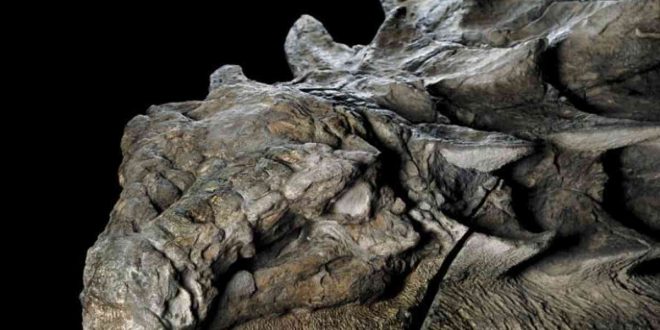Way back in 2011, Shawn Funk was digging in Alberta’s Millennium Mine, when he hit “something much harder than the surrounding rock.” And upon closer inspection he discovered that it was actually a dinosaur fossil — but not like other fossils discovered. This fossil was almost completely intact.
The fossil is said to the 110 million-year-old remains of a Nodosaur, a dinosaur that was around 18 feet long on average and weighed up to 3,000 pounds. The dinosaur also had 20-inch-long spikes that came out of its shoulders for protection.
Although it’s not clear whether the size of these spikes affected the beast’s attractiveness to the opposite sex, it’s thought that the combo of armour and barb was a key part of its mating ritual.
“This armour was clearly providing protection, but those elaborated horns on the front of its body would have been almost like a billboard,” said paleobiologist Jakob Vinther from the University of Bristol.
A Canadian heavy equipment operator discovered the stunning fossilised remains at a mine in Alberta, Western Canada.
It was then carefully dug out of the ground and handed over to scientists, who painstakingly exposed the beast’s remains.
Chemical tests have revealed traces of the dinosaur’s pigment, leading scientists to suggest it was a reddish colour with lighter horns.
The monster’s armour and natural weapons would have served the dual purpose of scaring enemies and attracting mates.
It may have used its spikes during battles to win the affection of a member of the opposite sex.
Normally, dinosaurs’ armour is ruined during the process of decay and fossilisation.
But the nodosaur’s bony plates and the scales between them have remained relatively intact.
Vinther said the fossil was so pristine that it “might have been walking around a couple of weeks ago”.
Sheaths made of keratin – the substance human finger nails are made from – still coat the plates, which are called osteoderms.
These sheaths made the dinosaur look more scary and imposing by exaggerating the extent of its armour.
“I’ve been calling this one the Rosetta stone for armour,” added Donald Henderson, curator of dinosaurs at the Royal Tyrrell Museum.
The body of the nodosaur is thought to have washed up in a river, before being swept out to sea where its sunk into the mud and was encased in minerals which allowed its shape to be preserved whilst layers of rock covered it over millions of years.
Now, the fossilised dinosaur is set to go on display at the Royal Tyrrell Museum, so humans will be able to decide whether this scaly beast’s spikes and armour made it a lover – or a fighter.
Scientists recently discovered the world’s largest dinosaur footprint – and it was as big as a grown man.
https://www.youtube.com/watch?v=0-fPuQ-YULY
Agencies/Canadajournal
 Canada Journal – News of the World Articles and videos to bring you the biggest Canadian news stories from across the country every day
Canada Journal – News of the World Articles and videos to bring you the biggest Canadian news stories from across the country every day



